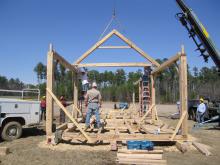Information Possibly Outdated
The information presented on this page was originally released on September 25, 2008. It may not be outdated, but please search our site for more current information. If you plan to quote or reference this information in a publication, please check with the Extension specialist or author before proceeding.
Students use new tools to learn timber framing craft
MISSISSIPPI STATE -- Mississippi State University forestry students are combining the modern technology of computer laptops and flash drives with traditional saws, mallets and squares to learn the time-honored craft of timber framing.
Students who took the “Wood in Design and Engineering” course offered this spring experienced a hands-on laboratory in this art.
Once a popular construction method, the craft of timber framing dates back to 6220 B.C. In the early 1900s, Sears and similar retailers sold thousands of timber frame homes through mail-order catalogs.
“Timber frame structures are designed so that each member interlocks with other members of the frame, with each joint individually carved and fitted,” said Lance Stewart, a doctoral candidate enrolled in the course. “We could not use nails or staples as fasteners, and since the parts are fabricated to fit, there is little room for error.”
Because the parts are not interchangeable, simple defects in a piece of lumber can cause problems. This requires thinking several steps ahead, Stewart added.
Laurie Grace, an MSU forestry professor, said timber frame homes were replaced over the years with the stud-and-platform building style.
“The durability, utility and function of wood as a material have led to a resurgence in this method of construction, especially in upscale residential and commercial markets,” she said.
Grace said the renewed interest in the technique gave her the idea to ask students in the course to construct a timber frame house.
“Working a piece of rough-cut wood to a finished product allows students to see firsthand how man-made and natural forces, both positive and negative, affect the lumber produced from a tree,” Grace said. “That is what we want forestry students to understand, not just in principle but also in actual application.”
Grace obtained the sweet gum trees from the university's John W. Starr Memorial Forest. Workers harvested the trees and cut the wood into 4-by-4 and 8-by-9 timbers.
“The plans were to build a 16-by-32-foot building in two sections; however, shortage of longer lumber lengths forced a design change to a 16-by-48-foot building in three sections,” Grace said.
Builders typically do not use sweet gum lumber in home construction, so the project provided students with a learning opportunity.
“Actually working with wood brings to light the many theoretical practices discussed in books but seldom seen or experienced,” Grace said.
Species differences, growth rates, grain patterns, fire damage, storm damage, insect damage, cutting technique and knots impact the usability of the lumber in ways that builders of the past did not fully realize, Grace said.
Even students with previous construction experience found the project challenging. Nine undergraduate and graduate students and their friends worked on the pieces during nights and weekends in MSU forestry professor Bill Stuart's shop. The final assembly included 275 finished pieces and took three days to erect.
The structure was on exhibit in June at the Mid-South Forestry Equipment Show and provided continuing education learning for loggers and professional foresters. The house will remain as a permanent demonstration structure in the John W. Starr Memorial Forest to determine how sweet gum lumber performs in this application.
“The structure also will allow scientists to determine the durability of timber frame construction in the modern environment,” Grace said. “This type of project has potential for development in Southern markets and can create business opportunities for small firms in rural communities.”




